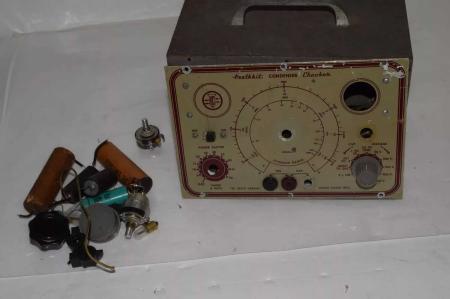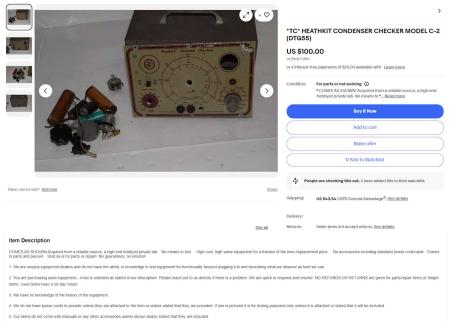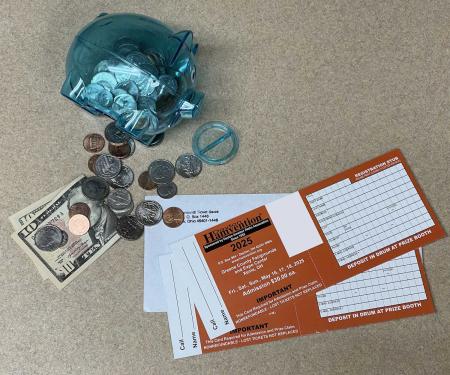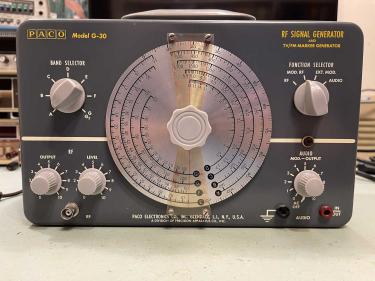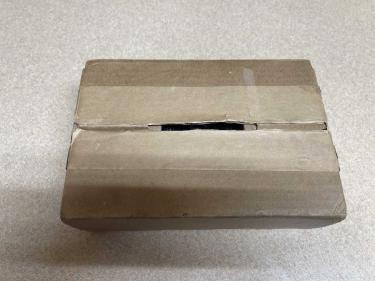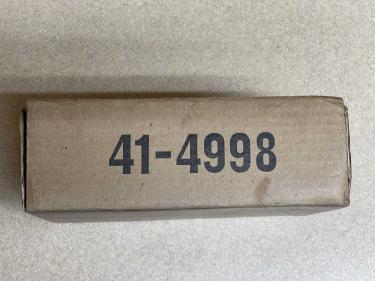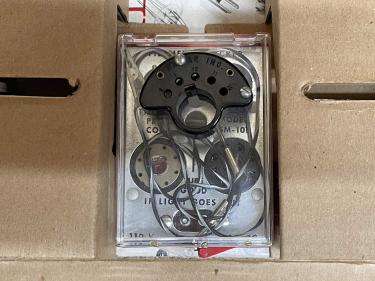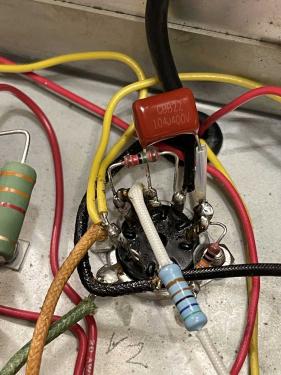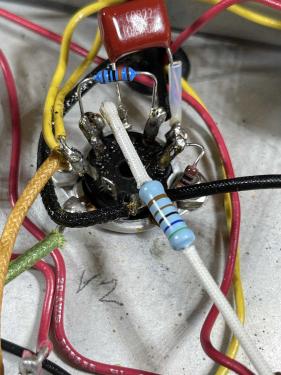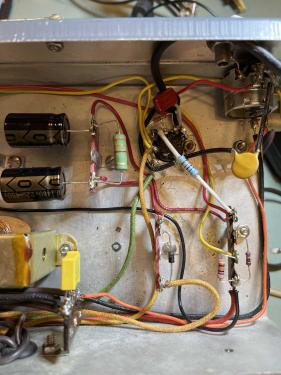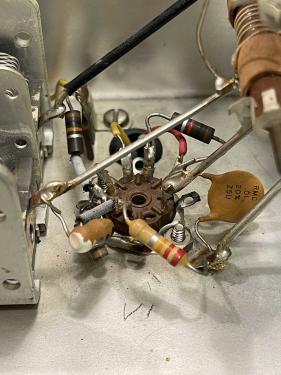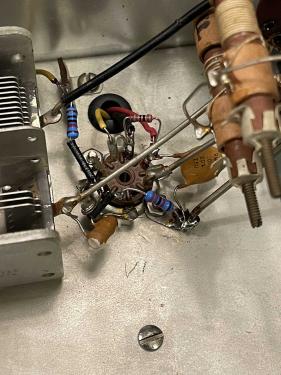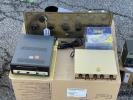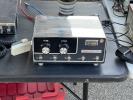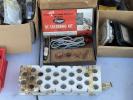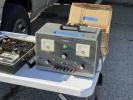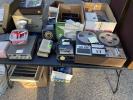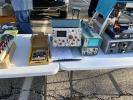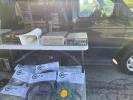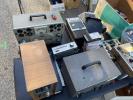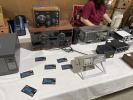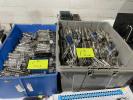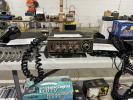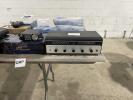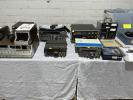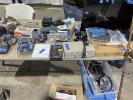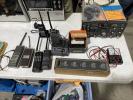- 2025
- May
- 14
Crap from eBay #2 - “High cost, high value”
Here’s a Heathkit C-2 “Condenser Analyzer” for sale. It’s listed at $100 with almost $44 in shipping.
For some reason, capacitor analyzers of this nature have become the hot thing. It’s in part due to the glowing green magic eye tube that these used as their primary output display indicator, but also (I’ve been told) people use these and their high-voltage outputs to “reform” old capacitors for reuse. Why? I guess because the Internet told them that old=good, new=garbage.
You’ll notice this thing is in fairly poor condition. It has a pile of parts included with it. Some of them obviously came from the device. Some did not. All of them had to be cut out of circuit in order to be in this pile. It looks like someone just grabbed a handful of things nearby and added them to the image.
These devices were a very simplistic variant of the capacitor checker, and had a small chassis at the top that contained the power and eye tube circuitry. It appears to still be there by the screws in the panel, but that’s about it. The eye tube is missing. Two of the three controls are missing (are they in the pile?) The leakage lamp is gone, and the panel is, overall, in poor condition. We can’t see the chassis itself anywhere so there’s no guarantees that anything other than the metal is still there. Even that is suspect!
The front panel is in poor condition, but the case is in just as bad of condition. It’s intact, but rusty. The handle is still there, which is good, but that’s about it. No power cord is present, so it’s probably been cut off for some reason.
If I were to see this at a hamfest, it would probably be in the dollar box, or even the “free” box. I’d take it for a buck to get the aluminum handle and knob and dump the rest in the trash on the way out. This, in my opinion, is certainly not $144.00 worth of anything.
The good part is the description:
There’s our images again. You can plainly see they aren’t showing a chassis here, even though all of the screws are missing and it would be easy to do so. Why not? Why show the pile of parts close up but not the chassis?
But as stated, the description is pure gold.
“Acquired from a reliable source.” What’s that supposed to mean?
A “High end hobbyist private lab.” If this is the case, then this was in their junk bin.
“No means to test.” No kidding. Really? The exploded view is laying on the bench, exploded.
“High cost, high value equipment for a fraction of the new/replacement price.” Again, what is this supposed to mean? I can get a brand new device that does everything but leakage for $25, with the added bonus of testing every other common part as well.
(Leakage is not necessarily as useful as it seems. These devices were designed to test paper, mica, and electrolytics of the 1940s-1960s. Chances are, all of those old paper and electrolytics are bad and will get replaced regardless, so who cares if they leak? They need to be replaced.)
Much of this listing is boilerplate from the seller, and they use it in all listings. But some of it, in my opinion, is deliberately playing on a potential buyer’s desire to own one of these, even if they don’t fully understand the device. While I have no problem with selling this device itself (I used to sell used and parts-only things on eBay years ago) this device is (again, my opinion only!) being deliberately puffed up in order to make it appear it’s something it’s not. I don’t know if this is malicious or if it’s just the seller’s lack of knowledge - but with the other things seller has listed I think I’d be well within rights to assume they have some knowledge of this device.
Of course, it’s buyer beware on eBay, but still. Treat your customers with a little respect here. You got junk, sell it at a junk price!
If you do want one of these, there are several examples of the better C-3 device available, for substantially less than this one. Many of those are demonstrated working.
This one is here because the seller seems to be playing on the desire for this kind of device, even though the example they have will probably never be operational again.
Buyer beware!
- 2025
- May
- 14
The 2025 Scioto Valley Amateur Radio Club Hamfest - May 24th 2025
There’s a small hamfest in Piketon, OH on the weekend of the 24th - if you didn’t get enough junque at Dayton.
I attended this one last year (except it was in October,) and pulled a few good deals out - including my IG-72 Signal Generator. I’m pretty sure I was at this one a couple times in the 90s, but who knows - that’s too long ago for me to remember.
It was a small but decent local show, and if you’re in the area it’s worth stopping by.
Scioto Valley Amateur Radio Club Hamfest
Saturday May 24th
Pike County Fairgrounds
311 Mill Street
Piketon, OH 45661
8A - Noonish
https://www.arrl.org … radio-club-hamfest-3
Bonus, there’s one of the few remaining Rax Roast Beef joints just north on US23!
- 2025
- May
- 9
The Dayton Hamvention is happening in a week.
Break open mister piggy because it’s almost time for the Dayton Hamvention. You still have time to get tickets at a discount rate, but they’re being held will-call at the ticket booth on site.
Times are:
Friday, May 16th - 9A to 5P <--- Probably the best day to go.
Saturday, May 17th - 9A to 5P
Sunday, May 18th - 9A to 1P <--- Vendors leave, but some have free stuff!
Forecast, as of Wednesday the 14th:
Friday: Sunny and 86 with a chance of early afternoon showers.
Saturday: Sunny and 78 with a chance of early morning showers.
Sunday: Sunny and 75.
(Things have changed to be a bit more rainy. May want to pack some gear!)
I’ll have pictures posted as soon as I can get them processed - probably the following week. I’ve got a few items on my want list, and I’ll post anything I pick up that’s unusual or really interesting.
Tickets can be purchased online at: https://hamvention.org/purchase-tickets/
See you there!
It was a good show. Here’s my photos:
Friday’s Pictures: https://wereboar.com … 5-dayton-hamvention/
Saturday’s Pictures: https://wereboar.com … 5-dayton-hamvention/
Sunday’s Pictures: Didn’t make it back on Sunday.
- 2025
- May
- 6
Crap from eBay #1 - “Doubles as a tube tester!”
(This was called AI Crap…but I decided there’s so much normal crap on eBay that I should rename the series!)
eBay was both a bane and a boon to the electronics world. A boon because it allowed more people to sell off equipment and and materiel (that they may not have had a venue for) to a wider audience, but a bane because it took some of those things out of the hamfest market and put them up for a much higher price. While I don’t blame people for trying to get more money out of stuff, prices on eBay can be insane.
To add to the crazy, people who have zero knowledge of what they are selling now have AI available to write them a description instead of a “Says XXXX, no idea how to test.” AI, invariably, is wrong about this stuff because no one is using this antique stuff to do what it says it does. It gives sellers a false sense of what the device does and what it’s used for, and invariably feeds the “tubes = money” attitude that the layman has. Just because it has vacuum tubes in it doesn’t mean that it’s valuable, useful, or even interesting.
This is the first in a not-often series of wacky stuff I see on eBay. This one is a “Vintage Micronta Volt DC Multi tester Milliamperes Amp Tube Tester.”
It’s obviously someone’s homebrew power supply with Micronta (Radio Shack) meters on the front. Case would date it to the 70s, most likely.
AI has written a lovely line of BS for this device:
“This vintage Micronta multi tester is a must-have for any collector or enthusiast of vintage technology. With its analog display and benchtop form factor, it’s perfect for testing DC voltage and milliamperes. It also doubles as a tube tester, making it a versatile tool for any hobbyist or professional in the test and measurement industry.
This product features the brand’s signature quality and durability, and is sure to impress with its vintage charm. Whether you’re a collector or looking for a reliable multi tester, this Micronta model is the perfect addition to any workspace.”
I’m not sure how a power supply tests DC voltage, or even how you test a milliamp. Do you give it a quiz? If you have one joule per coulomb, how many volts is that?
It then goes on to say that it doubles as a tube tester. While I guess you could technically test the filaments of a tube with this, it’s nothing of the sort - any power source will do that for you, assuming it’s the correct voltage.
And then there’s the standard boilerplate that let’s you know AI wrote this, that of how it features the brand’s quality and reliability even though someone built this from their junk box - the only thing missing is how it’s widely used in the industry. It tried, though, with the “if you’re looking for a reliable multi tester…”
I got a giggle out of this one, not because of what it is, but of how it’s being described. It’s been for sale for some time, I don’t expect it to go anywhere soon.
- 2025
- Apr
- 30
A PACO G-30 RF Signal Generator - Part 7: Wrapup
Now that the PACO G-30 is working, and is probably in a bit better shape than it was than before I purchased it, it’s time to take a look back on what happened with it.
When I purchased the unit at Findlay 2022, it was sold working. And it was - mostly. I didn’t check the audio portion, but the RF worked fine. The previous owner had removed some of the old capacitors and replaced a few of the carbon composite resistors. He hadn’t replaced them all as they were well within tolerance - surprising for high-value CC resistors. He had replaced the filters with a strange array of electrolytics. But what hadn’t been replaced was the across-the-line capacitors, as well as the selenium rectifier.
The across-the-line cap was of the three-leg type, a device that has two units back to back with a common leg. They’re well known for blowing apart, and that this one hadn’t done so was surprising. The other device was the original selenium rectifier.
Selenium devices were a stop-gap measure between vacuum rectifiers and silicon rectifiers. They worked fine when new, but as they age the forward voltage drop of the device increases. This happens used or unused. Get enough resistance there, you get more voltage drop, more drop means more heat, more heat means that eventually you’re going to wind up with a device that burns open and releases a lot of toxic smoke into your space. You don’t want that, so replacing it is mandatory. Sure, it’s probably still going to work (for a while,) but it’s a case of when, not if it goes bad.
For the most part, this was just a replace the parts that are known to go bad (mostly done,) replace the carbon resistors because they will eventually go bad (mostly done,) and fix some of the issues left by the previous owner. The across-the-line capacitor was easy enough to replace with modern safety caps, and the old line cord was replaced with a new polarized cord.
As stated, the selenium rectifier is a part that was destined to fail from birth. It needs to be replaced, and for a small rectifier like the one in this device, it’s easy to replace with a 1N4007 silicon. I used this type because I have them on hand, but you could use any diode that exceeds the miniscule current rating, and at least 200V. (You should go higher than this for safety margins.)
There are some considerations to look at here. You’ll need to remember that the silicon rectifier drops much less voltage than a selenium, so some sort of dropping resistor will be needed. There was already a 2.2kΩ resistor in the power supply circuit between the two filter capacitors, so changing that was easy. You’ll need to make sure to measure the current to do some basic calculations and see what you need to raise that value to, but in this case I already knew ~3.3kΩ would work as others have taken the time to do the calcs.
Another consideration you’ll need to make is that full peak voltage of the line will appear on the capacitors until the set is warm and drawing current. Therefore, any capacitors you use will need to handle at least this voltage. The old ones may not have been rated for this, but those old paper capacitors could handle surges much better than modern stuff. Modern parts are easier to get with higher voltages, so don’t be afraid to use 300WVDC or 450WVDC capacitors here.
Resistors are the last consideration you need to look at. Remember that you’re working with higher voltages than a battery device - you need resistors rated for at least your maximum B+ voltage, be it the rectified voltage or the Peak voltage that you see on the filters. Most resistors are rated for at least 300WVDC these days, so you’re good for this device - but if you’re working with 400, 800, or higher - your resistors need to be rated for this higher voltage. In carbon resistors, you’ll see ones that are longer than normal and that gives you a clear indication that it’s a high voltage part. Modern parts give you no such indication, so buy your parts from a reputable house.
Resistors also have to be rated for your surge currents. Carbon resistors can handle surges, and that’s especially important here where you have full voltage on your circuit at the start. Rate it small, and your metal film resistor is a fuse. Don’t be afraid to step up the power rating on resistors in power supplies and other areas where you’re going to be supplying current and voltage to the rest of the system.
What did I specifically run into?
First - I forgot how selenium rectifiers work in a vacuum circuit. It’s been far too long since I’ve seen this type of device, so it took some remembering.
When I first turned on the set, I had a 150WVDC capacitor after the dropping resistor. As the entire of the peak line voltage appeared here (180VDC) I went crap and turned it off. It took a while to remember that the rest of the set isn’t hot and wanting current, so the voltage drops in the power supply aren’t there yet. A quick swap with a 450WVDC part and a bit of waiting, and B+ dropped right back to where it should be, which is ~110VDC.
Second - I didn’t have any audio on the audio side. This turned out to be a part the previous owner installed. The grid of the audio oscillator was supposed to have a 100kΩ resistor, The previous owner had a 15kΩ resistor here, which is what I replaced it with as I replaced each component individually with it’s modern equivalent. Once I put the proper value in the circuit and a new tube (the old one didn’t seem to work well) it came right up. It’s a bit off in frequency, but it’s not really of importance as it’s there for you to hear, not compare to the sounds of nature.
This unit is a good example of why you examine devices closely when you’re working with them - especially when someone else has been in there first. A schematic is essential for this, so make sure you have all your docs in order.
That’s about all - other than the wrong part leftover from the former owner, this was a simple “bring it into the modern age” device. Next up is probably an Eico 24x VTVM, but it’s also another “just needs resistors” device. It just needs a lot of resistors as the divider ladders in the measurement circuit are all out of tolerance. Stay tuned!
A PACO G-30 RF Signal Generator: https://wereboar.com … rf-signal-generator/
A PACO G-30 RF Signal Generator - Part 2: Revisiting https://wereboar.com … r-part-2-revisiting/
A PACO G-30 RF Signal Generator - Part 3: Parts https://wereboar.com … erator-part-3-parts/
A PACO G-30 RF Signal Generator - Part 4: The power supply: https://wereboar.com … -4-the-power-supply/
A PACO G-30 RF Signal Generator - Part 5: Resistors: https://wereboar.com … or-part-5-resistors/
A PACO G-30 RF Signal Generator - Part 6: Troubleshooting: https://wereboar.com … t-6-troubleshooting/
A PACO G-30 RF Signal Generator - Part 7: Wrapup: You’re reading it now!
Previous part of this series: https://wereboar.com … t-6-troubleshooting/
Addendum - It was pointed out to me that some of the other parts installed by the previous owner are incorrect, per the schematic.
A PACO G-30 RF Signal Generator - Part 8: So we meet again: https://wereboar.com … -8-so-we-meet-again/
- 2025
- Apr
- 28
A Tricraft Products Corp SM-101 Filament Checker
I picked this little gadget up at the ACARA hamfest. Not because I plan on using it, but because it’s an unusual little thing and had a brand new book with it.
It’s a rather unassuming box with a number on the side.
What’s inside is this little gadget, a power cord, and a book. The gadget:
It claims to be a Tricraft Products Corp SM-101 Filament Checker. I’m not sure how it works because there’s no instructions for the device. It appears to be used, but only very little. I can see some wiping on the contacts. The power cord was unrolled and rolled back up with bread ties.
I can’t imagine this was terribly useful, your VOM would have been quicker than getting out a power cord and plugging all kinds of little pins together in an attempt see if the filament was good.
The real gem is the book. The RCA Tube Manual RC-19 from 1959. It appears to be unused, if a little dirty.
That’s worth the few dollars I paid for it right there. The other piece? A cool gimmick gadget for display.
- 2025
- Apr
- 28
A PACO G-30 RF Signal Generator - Part 6: Troubleshooting
I’ve discovered the audio side of this unit doesn’t work. When you get a device like this, you can assume one of three things (and this applies to the state this device was in when received.)
1: There’s something wrong, i.e. something is broken.
2: You put a part in wrong, or made a mistake in replacing parts.
3: The previous owner did something wrong, and you followed in his (incorrect) footsteps.
I started this by checking the plate and grid voltages.
A word about this device: I can’t seem to figure out where they measured from here - Chassis is ground, but the device also is raised about 8V above ground to provide a negative voltage. Some measurements seem to be from chassis, some from raised ground (return). I wasn’t able to get some of the marked voltages, so…who knows. Bob from Accounting probably drew the schematic for this at lunch so it’s possible something isn’t exactly right.
Regardless, B+ was correct on the 6C4 audio oscillator. Grid was not, so ah-ha, there’s my problem. Well..not necessarily in this case because you could go to return and get a different voltage for each measurement. But in this case, it was the problem.
I discovered this because I looked at each part I took out and did a like-for-like comparison with what I put in. Everything matched. The problem became apparent once I really started looking at the schematic.
So, you’ll notice there’s a 15KΩ resistor coming from Pin 6 of the 6C4. That’s what the previous owner had in there.
The schematic, however, states that we need a 100kΩ resistor:
That’s probably the problem. I had some 100kΩ left from one of the previous rebuilds, where I wisely just bought a bunch. One of those goes in:
It still didn’t work, so I grabbed the tube from a parts unit I got at Columbus…
And, there’s our audio.
It’s 500Hz instead of 400Hz, but who cares. It’s still going to be heard just fine. The bad grid resistor destroyed the original tube, but…oh well.
Since the device is now working, it’s time to button up for the wrapup post. Stay tuned!
Next part of this series: https://wereboar.com … rator-part-7-wrapup/
Previous part of this series: https://wereboar.com … or-part-5-resistors/
- 2025
- Apr
- 28
A PACO G-30 RF Signal Generator - Part 5: Resistors
After confirming the power supply was operational (and remembering how that works!) I started in on the resistors.
Some had been replaced before I received the unit (foreshadowing!) and some were original. It was a mix of modern film, old film and old carbon comp resistors. I have to wonder if these were the special military units, as the remaining carbon comp parts were well within tolerance. Considering I’ve seen multiple of this particular device and every one of them has a different style of parts inside, it’s hard to tell.
I decided to just do them one at a time. Unsolder, remove, and replace with the same value. At least, the same value as what’s in the unit now.
Here’s the bottom after replacing the resistors, diode, and capacitors (yay bad lighting!)
This is what the top looked like before replacement:
And after:
After a quick inspection, I fire it up. RF looks good - for the given value of good this device offers. The audio side? Not so much, there’s nothing there. Uh oh…stay tuned for troubleshooting.
Next part of this series: https://wereboar.com … t-6-troubleshooting/
Previous part of this series: https://wereboar.com … -4-the-power-supply/
- 2025
- Apr
- 28
Photos from the 2025 ACARA Hamfest.
This was my first time attending this event. It was an easy drive, so I decided why not? This took place at the Athens Community Center in Athens, OH, and featured about two dozen vendors in a sheltered parking area as well as a couple in the center itself.
This one had a different selection of gear, with more test equipment and consumer gear appearing to show up at this one. Of course, a handful from TUSCO were also here, so I saw some of the same stuff (but didn’t photograph it as you and I have already seen it!)
As with the other shows this year, I’ve noted that prices are trending upwards, especially on those things that are considered cachet - Simpson 260 devices and tube testers are commanding higher prices again, even if they’re a bog-standard bottom of the barrel emissions tester. Dayton will be the tell on this one, if prices there are back to normal we know the economy is doing better.
Here’s what I saw at the show:
.
As I wandered through the show, I overheard someone saying that he’s not going back to Dayton because it’s held at Xenia now. “HARA was a dump but it was my dump! and I don’t like Xenia.” I had to lol, ok dude - I appreciate being able to walk through the parking lot and not twist my ankles, so you can stay away and I’ll buy the junk. HARA was certainly a dump, and I don’t miss the burnt mystery burgers and the dimestore nachos.
Speaking of Dayton, the Hamvention (as of this writing) is only about 3 weeks away. I’ll certainly see you there, but if you can’t attend then come back for pictures shortly after.
- 2025
- Apr
- 28
Photos from the 2025 TUSCO Hamfest
This is a small show at the Tuscarawas County fairgrounds in Dover, Ohio. I’ve been attending since 2023, when they reopened after the country decided that they needed to not do anything for a few years.
This show seems to attract a decent crowd of vendors, and a decent crowd of attendees. I took home a few books and odds ‘n ends from this one, which is exactly what I expected.
.
Prices generally seem to be heading North this year, so get it while the getting is good. I did see some things that were not very reasonably priced - they would have been fine 10 years ago, but with technology changes things that were portable then are obsolete now.
Not a whole lot else to say about this one, so enjoy the photos - ACARA’s photos are coming up next.
